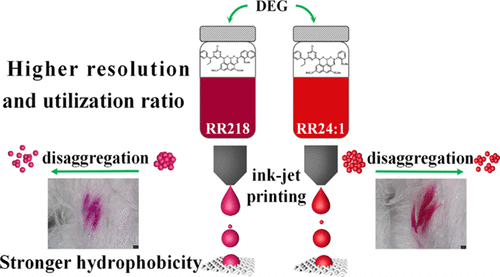当前位置:
X-MOL 学术
›
ACS Sustain. Chem. Eng.
›
论文详情
Our official English website, www.x-mol.net, welcomes your
feedback! (Note: you will need to create a separate account there.)
Insights into Influences of Dye Hydrophobicity on Cleanliness and Resolution of Fabric Ink-Jet Printing
ACS Sustainable Chemistry & Engineering ( IF 7.1 ) Pub Date : 2020-11-13 , DOI: 10.1021/acssuschemeng.0c06447 Haibo Qin 1, 2, 3 , Kuanjun Fang 1, 2, 3 , Yanfei Ren 1, 2, 3, 4 , Kun Zhang 1, 2, 3 , Liyuan Zhang 1, 2, 3 , Xiaoyu Zhang 1, 2, 3
ACS Sustainable Chemistry & Engineering ( IF 7.1 ) Pub Date : 2020-11-13 , DOI: 10.1021/acssuschemeng.0c06447 Haibo Qin 1, 2, 3 , Kuanjun Fang 1, 2, 3 , Yanfei Ren 1, 2, 3, 4 , Kun Zhang 1, 2, 3 , Liyuan Zhang 1, 2, 3 , Xiaoyu Zhang 1, 2, 3
Affiliation

|
Fabric ink-jet printing is a crucial technology of clean production in the textile industry. Reactive dyes and organic solvents are the important component of ink-jet printing ink. The structure, hydrophobicity, and aggregation degree of reactive dye affect the amount of organic solvent and ink droplets spread on fabric, which is essential for reducing organic solvent dosage and obtaining high quality ink-jet printing images on fabric. In this study, two red reactive dyes (reactive red 218 dye and reactive red 24:1) with different structures were used to prepare reactive dye solutions, which were subsequently explored by investigating the surface tension, rheological properties, visible absorption spectra, and droplet formation and observing the spreading behavior on cotton fabrics. For the first time, the effects of dye hydrophobicity on organic solvent dosage and ink-jet image resolution were studied. The results showed that reactive red 218 dyes possessed stronger hydrophobicity and more compact aggregation. Reactive red 218 clusters were more easily disaggregated into dye monomers through the hydrophobic interaction between the DEG and dye molecules, while reactive red 24:1 clusters were disaggregated into small clusters. Reactive red 218 solution droplets were more stable, which could reduce the air pollution caused by the satellite droplets. Based on the above reasons, the solution of dye with stronger hydrophobicity required less organic solvent and had a smaller droplet spread area (represents higher printing resolution) on the fabric. These findings provided a novel direction for reducing organic solvent consumption and improving the utilization rate of dye solution.
中文翻译:

染料疏水性对织物喷墨打印的清洁度和分辨率的影响的见解
织物喷墨印刷是纺织工业清洁生产的关键技术。活性染料和有机溶剂是喷墨印刷油墨的重要成分。活性染料的结构,疏水性和聚集度会影响有机溶剂和分布在织物上的墨滴的量,这对于减少有机溶剂的用量并在织物上获得高质量的喷墨打印图像至关重要。在这项研究中,使用具有不同结构的两种红色活性染料(活性红色218染料和活性红色24:1)制备活性染料溶液,随后通过研究其表面张力,流变性质,可见吸收光谱和液滴来探索它们。形成并观察棉织物上的铺展行为。首次,研究了染料疏水性对有机溶剂用量和喷墨图像分辨率的影响。结果表明,活性红218染料具有较强的疏水性和更紧密的聚集。通过DEG和染料分子之间的疏水相互作用,活性红218簇更容易分解为染料单体,而活性红24:1簇则分解为小簇。活性红色218溶液液滴更稳定,可以减少由卫星液滴引起的空气污染。基于上述原因,具有较强疏水性的染料溶液需要较少的有机溶剂,并且在织物上的液滴分布面积较小(代表较高的印刷分辨率)。
更新日期:2020-11-23
中文翻译:

染料疏水性对织物喷墨打印的清洁度和分辨率的影响的见解
织物喷墨印刷是纺织工业清洁生产的关键技术。活性染料和有机溶剂是喷墨印刷油墨的重要成分。活性染料的结构,疏水性和聚集度会影响有机溶剂和分布在织物上的墨滴的量,这对于减少有机溶剂的用量并在织物上获得高质量的喷墨打印图像至关重要。在这项研究中,使用具有不同结构的两种红色活性染料(活性红色218染料和活性红色24:1)制备活性染料溶液,随后通过研究其表面张力,流变性质,可见吸收光谱和液滴来探索它们。形成并观察棉织物上的铺展行为。首次,研究了染料疏水性对有机溶剂用量和喷墨图像分辨率的影响。结果表明,活性红218染料具有较强的疏水性和更紧密的聚集。通过DEG和染料分子之间的疏水相互作用,活性红218簇更容易分解为染料单体,而活性红24:1簇则分解为小簇。活性红色218溶液液滴更稳定,可以减少由卫星液滴引起的空气污染。基于上述原因,具有较强疏水性的染料溶液需要较少的有机溶剂,并且在织物上的液滴分布面积较小(代表较高的印刷分辨率)。











































 京公网安备 11010802027423号
京公网安备 11010802027423号